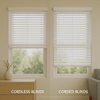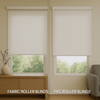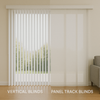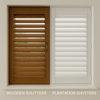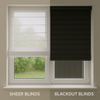Cordless Blinds vs. Corded Blinds: Which Option is Safer and More Convenient?
- by Mariam Labadze
 Quick Answer
Quick Answer
Cordless window treatments eliminate dangling cords through spring-loaded mechanisms or integrated handles, providing superior child safety whilst creating cleaner aesthetics. Corded versions use traditional pull cords or chains for operation, typically costing 10-20% less and offering easier operation for very large or heavy treatments. Cordless systems are mandatory in UK homes with children under 42 months, making them essential for nurseries and family spaces. They suit modern minimalist interiors and provide peace of mind through enhanced safety. Corded options remain viable for adult-only households, high windows beyond children's reach, or budget-conscious projects where cost savings matter significantly.
[toc]
Understanding the Safety Imperative
-
Child safety compliance – UK regulations require cordless or safe cord systems in homes with young children under 42 months
-
Strangulation risk elimination – Cordless designs remove the primary hazard associated with traditional window coverings
-
Aesthetic benefits – Absence of cords creates cleaner, more streamlined window appearances
-
Operational differences – Cordless uses push-up/pull-down or handles; corded employs chains or traditional cord mechanisms
-
Cost considerations – Cordless typically costs £10-£30 more per window than corded equivalents
-
Ease of use – Cordless suits standard windows; corded better for very large or high installations
-
Maintenance requirements – Both require minimal upkeep, though spring mechanisms may need occasional adjustment
The Child Safety Crisis That Changed Everything
Tragic accidents involving window covering cords prompted significant safety reforms across the UK and internationally. Loop cords, continuous chains, and dangling pulls created strangulation hazards that claimed young lives, leading to mandatory safety standards transforming the industry.
Modern UK regulations require all window coverings in homes with children under 42 months to feature either cordless operation or approved safety devices preventing cord loops forming. These standards apply to both new purchases and existing installations, making compliance a legal responsibility for parents and caregivers.
The statistics driving these regulations prove sobering. Even brief moments of inattention can result in tragedy when curious toddlers encounter accessible cords near cribs, beds, or play areas. Eliminating this hazard entirely through cordless designs provides absolute protection impossible to achieve with cord management systems alone.
Beyond legal requirements, cordless options offer peace of mind for parents, grandparents, and caregivers. Knowing that window treatments present zero strangulation risk allows focus on other childproofing concerns without worrying about this particular hazard lurking in every room.
Rental properties and childcare facilities face particular scrutiny regarding window covering safety. Landlords and facility operators must ensure compliance with current standards, making cordless systems not just safer but legally necessary in these contexts.
The Multiple Benefits of Modern Blinds
Quality window treatments deliver advantages extending far beyond simple light control and privacy. Understanding these comprehensive benefits helps homeowners appreciate why investing in appropriate solutions enhances homes significantly.
Enhanced Privacy Without Sacrificing Light – Blinds allow precise control over visibility whilst admitting natural daylight. Angle slats or adjust positioning to prevent outside views whilst maintaining bright, welcoming interiors. This flexibility proves impossible with simple curtains that operate in basic open or closed positions.
Superior Light Management – Adjustable slats or variable positioning enables fine-tuning natural light throughout the day. Reduce harsh afternoon glare for comfortable television viewing, maximize morning brightness energizing your day, or create ambient evening lighting supporting relaxation. This dynamic control enhances comfort and functionality in every room.
Energy Efficiency and Cost Savings – Properly selected window treatments create insulating barriers reducing heat loss during cold months and blocking solar heat gain in summer. This thermal performance lowers heating and cooling costs significantly—quality treatments can reduce energy bills by 15-25% whilst improving comfort through more stable indoor temperatures.
UV Protection for Furnishings – Sunlight damages furniture, flooring, and artwork through ultraviolet radiation that fades colors and degrades materials. Blinds filter harmful UV rays whilst admitting visible light, extending the lifespan of expensive furnishings and preserving interior appearances for years longer than unprotected windows allow.
Noise Reduction – Window treatments, particularly cellular or honeycomb designs, dampen external noise from traffic, neighbors, or street activity. This acoustic benefit proves valuable in urban locations or homes near busy roads where peace and quiet significantly enhance living quality.
Increased Property Value – Quality window treatments signal well-maintained homes to potential buyers. Modern, stylish solutions throughout your property enhance appeal whilst demonstrating attention to detail that serious buyers recognize and value, potentially accelerating sales and supporting asking prices.
Low Maintenance Convenience – Unlike fabric curtains requiring regular washing or professional cleaning, blinds need only occasional dusting or wiping with damp cloths. This minimal maintenance saves time and expense whilst ensuring your window treatments always look fresh and presentable.
How Cordless Mechanisms Function
Spring-loaded systems represent the most common cordless technology. Raise the treatment by gently pulling downward on the bottom rail, engaging springs that hold position when released. Lower by pulling down slightly, releasing the spring mechanism, then guiding the treatment to desired height.
This operation feels intuitive after minimal practice, though first-time users sometimes struggle initially with the precise pull-down motion engaging springs. Quality systems respond smoothly to gentle pressure, whilst inferior mechanisms require forceful pulls or exhibit inconsistent behavior frustrating daily use.
Handle-operated designs feature discreet grips integrated into bottom rails. Pull the handle to raise or lower the treatment, with friction or ratcheting systems holding position once released. This approach works particularly well for heavier materials or wider windows where spring mechanisms might struggle.
Motorized cordless options eliminate manual operation entirely, combining cordless safety with effortless convenience. Remote controls, smartphone apps, or voice commands manage positioning without physical contact—the ultimate cordless solution though at premium pricing.
Top-down bottom-up configurations allow adjusting both top and bottom rails independently, providing privacy whilst admitting light through upper portions. This flexibility proves valuable in bathrooms, bedrooms, or ground-floor rooms where lower window coverage matters whilst natural light remains desirable.
The cordless design offers additional practical advantages beyond safety. Without dangling cords, blinds present cleaner appearances that suit modern interior design trends. Furniture placement becomes more flexible without needing to accommodate cord access, and the streamlined look contributes to uncluttered, sophisticated spaces.
Traditional Corded Operation Systems
Chain-operated mechanisms feature continuous loop chains hanging beside the window. Pull one side to raise the treatment, the other side to lower it. The chain's constant loop ensures smooth operation regardless of how many times you raise or lower throughout the day.
Traditional cord systems use pull cords that shorten as treatments rise and lengthen when lowered. These work effectively but create the safety hazards that drove regulatory changes. Modern versions incorporate tension devices and breakaway features reducing but not eliminating strangulation risks.
Wand controls offer compromise solutions—solid rigid wands replacing flexible cords whilst maintaining manual operation. Pull or push the wand to adjust positioning without creating loop hazards. This approach suits vertical treatments particularly well, providing safe operation without spring mechanisms.
Corded systems generally operate more smoothly on very large or heavy treatments. The mechanical advantage of pulleys and counterweights makes raising substantial window coverings manageable, whereas cordless spring mechanisms on identical treatments might require significant force or multiple adjustments achieving desired positioning.
High windows benefit from corded operation extending reach without ladders or step stools. Long chains or cords bring controls to comfortable operating heights, whilst cordless systems on tall windows require reaching the bottom rail—potentially impossible without assistance.
Despite safety concerns in homes with children, corded systems still offer practical advantages in specific situations. Adult-only households, commercial spaces, or installations beyond children's reach can benefit from the precise control and effortless operation that chain mechanisms provide, particularly on larger windows.
Aesthetic and Design Considerations
Cordless treatments create exceptionally clean appearances. Without chains, cords, or wands interrupting window lines, the treatments themselves become focal points. This minimalism suits contemporary interiors where every element contributes to uncluttered sophistication.
The absence of operating mechanisms allows furniture placement directly beneath windows without worrying about cord access or dangling chains catching on items. This flexibility proves valuable in compact rooms where every centimeter matters for optimal furniture arrangement.
Modern blinds enhance room aesthetics through coordinated color schemes, complementary textures, and architectural presence that elevates entire spaces. Whether choosing neutral tones that disappear into backgrounds or bold colors making design statements, quality treatments contribute meaningfully to interior design rather than simply covering windows.
Corded systems' visible chains or cords create slight visual interruption, though modern designs minimize this through discreet chain lengths and neutral colors blending with treatments. In traditionally decorated homes, these elements often go unnoticed, integrated naturally into overall aesthetic without seeming out of place.
Color-coordinated chains or cords can actually enhance rather than detract from appearances when thoughtfully selected. White chains on white treatments virtually disappear, whilst metallic chains complement contemporary hardware and fixtures creating cohesive design details.
Child safety devices required on corded systems—tension devices, cord stops, or breakaway connectors—add visual elements that some find unattractive. These necessary safety features can appear as afterthoughts rather than integrated design elements, particularly on otherwise sleek contemporary treatments.
Operational Convenience Comparison
Daily use patterns significantly influence which system proves more convenient. For standard-sized windows raised and lowered occasionally throughout the day, cordless operation feels natural and effortless. A simple pull adjusts positioning in seconds without thinking about cords or chains.
The convenience of cordless operation extends beyond mere ease of use. Quick adjustments throughout the day optimize natural light without disrupting activities—close blinds partially during afternoon glare whilst working on computers, then open fully later when harsh light subsides. This responsive light management enhances comfort and productivity.
Corded systems excel when precise positioning matters. The continuous operation of chains allows fine-tuning height exactly where desired, whilst spring-loaded cordless systems sometimes struggle with micro-adjustments, settling at slightly different positions than intended.
Multiple window operation favors cordless approaches. Moving through a room adjusting several treatments proceeds quickly with simple pull motions on each. Corded systems require locating chains that blend into surroundings, then performing deliberate pull sequences on each window.
Physical accessibility considerations affect convenience significantly. Elderly residents, those with arthritis, or anyone with reduced hand strength might find cordless spring mechanisms require more force than comfortable, whilst gentle chain pulls prove easier despite safety concerns when children aren't present.
Very large windows present cordless challenges. Raising heavy treatments against spring tension requires significant strength, and springs may not hold position reliably over time. Corded counterweight systems handle these applications effortlessly, making them practical choices despite aesthetic or safety compromises.
Cost Analysis and Value Proposition
Cordless treatments typically cost £10-£30 more per window than corded equivalents—modest premiums for the safety and aesthetic benefits delivered. On a whole-house project covering 10-12 windows, this adds £100-£360 to total costs, noticeable but rarely prohibitive for most budgets.
The cost difference reflects more complex mechanisms—springs, catches, and balance systems—compared to simple pulleys and cords. Manufacturing cordless systems requires tighter tolerances and higher quality components ensuring smooth, reliable operation throughout expected lifespans.
When evaluating value, consider the comprehensive benefits quality blinds provide. Energy savings reducing heating and cooling costs, UV protection extending furniture lifespan, enhanced privacy supporting comfort, and increased property value all contribute meaningful returns justifying initial investments. Quality window treatments pay dividends throughout their 10-15 year lifespans.
Long-term value calculations favor cordless options despite higher initial costs. The enhanced safety means no future upgrade expenses when children arrive or visit. Cordless treatments installed today remain compliant and safe regardless of household changes over coming years.
Resale considerations increasingly favor cordless installations. Safety-conscious buyers view cordless treatments as desirable features, whilst homes with outdated corded systems might require updates before sale. Installing cordless from the outset avoids this future expense whilst potentially enhancing property appeal.
Making Your Decision
Households with young children face straightforward decisions—cordless systems deliver legally required safety whilst providing clean aesthetics and convenient operation. The modest cost premium proves insignificant compared to child safety, making cordless the only responsible choice.
Adult-only households enjoy more flexibility weighing factors beyond safety requirements. Consider aesthetic preferences, operational convenience for your specific windows, and budget constraints determining which approach better suits your situation.
High windows, very large treatments, or physically challenging installations might justify corded systems even in family homes when treatments remain beyond children's reach. However, careful assessment of all accessible areas ensures no overlooked risks compromise safety.
Budget-conscious projects might use cordless in critical areas—children's bedrooms, playrooms, family living spaces—whilst selecting corded options for adult bedrooms, home offices, or guest rooms balancing safety where it matters most with cost savings where risks don't exist.
At 1 Click Blinds, safety remains paramount alongside style, functionality, and value. Modern cordless solutions combine child protection with the comprehensive benefits that quality window treatments provide—energy efficiency, light control, privacy, UV protection, and aesthetic enhancement. Understanding your household's specific needs—current and future—guides you toward solutions that enhance your home safely and beautifully for years ahead.

